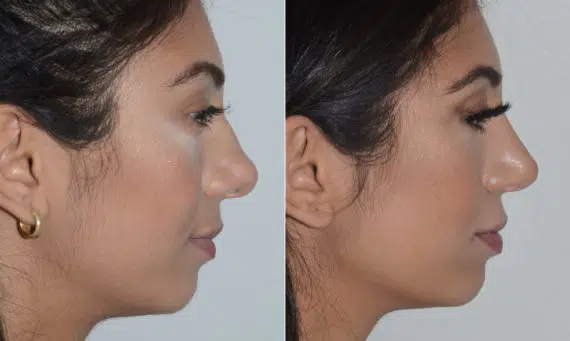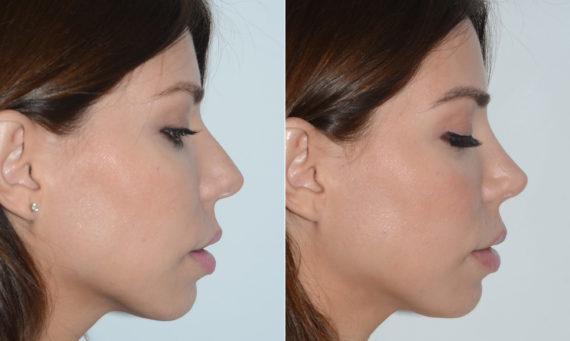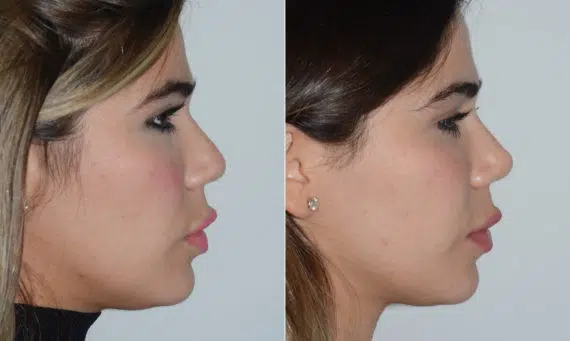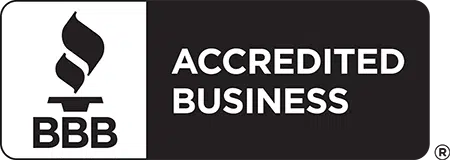Rhinoplasty surgery is a type of surgery that can help straighten your nose, making your face look proportionate again. You may have a crooked nose for various reasons, including a deviated septum, an old injury, or a congenital disability.
A crooked nose results from changes in the underlying structure of the nasal bones. While most people are okay with crooked noses, some struggle with their appearance and request surgery. Rhinoplasty corrects several cosmetic and functional issues and is used to repair a crooked nose or broken nose.
Rhinoplasty for a crooked nose may appear expensive, but the changes produce valuable benefits, such as increased self-esteem, more confidence, improved breathing, and cosmetic changes to appearance. Medical insurance may cover the cost of rhinoplasty in some cases.
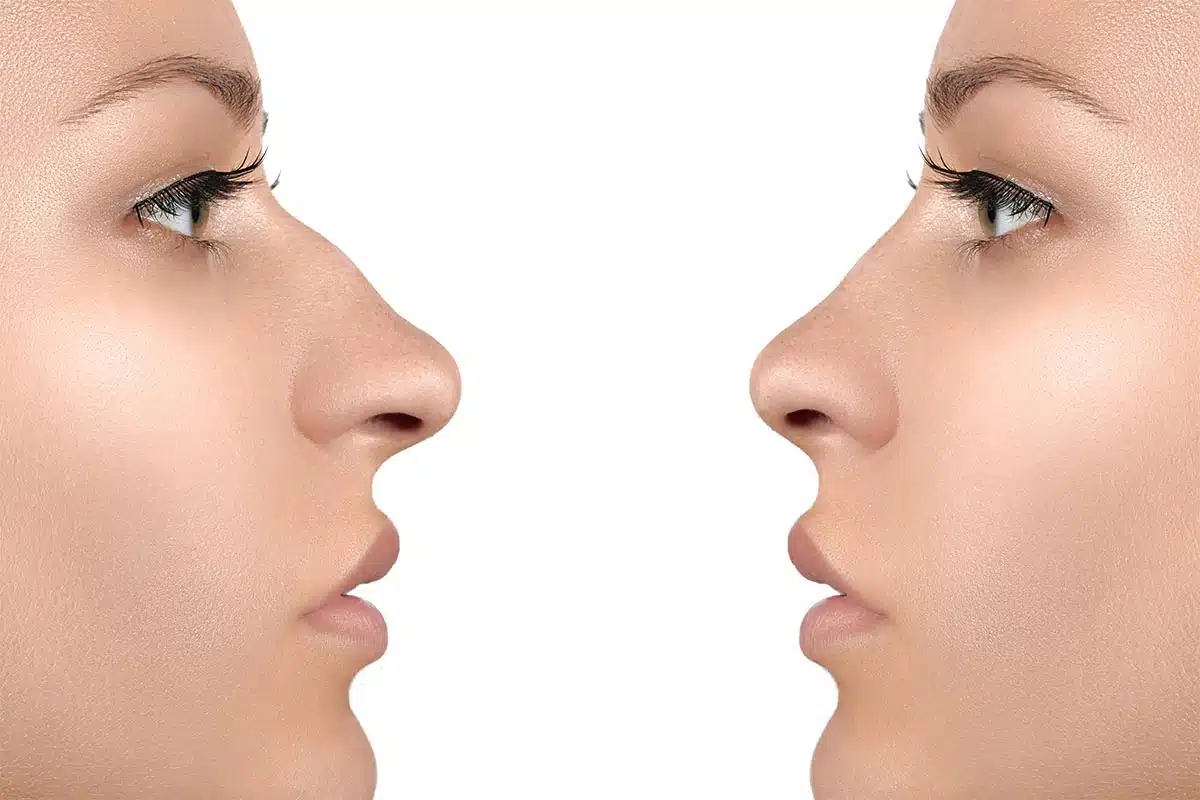
Rhinoplasty Can Straighten Your Nose
- Rhinoplasty, often known as a nose job, can correct a crooked nose, making it straighter and more symmetrical.
- The success of rhinoplasty in straightening a nose depends on the underlying cause, such as a deviated septum or previous injury.
- Recovery from rhinoplasty to correct a crooked nose typically involves swelling and bruising, lasting several weeks.
- Consulting with a qualified plastic surgeon is essential to understand the realistic outcomes and risks involved in the procedure.
- Non-surgical options like fillers might offer temporary solutions but cannot permanently straighten a crooked nose.
The Anatomy of a Crooked Nose
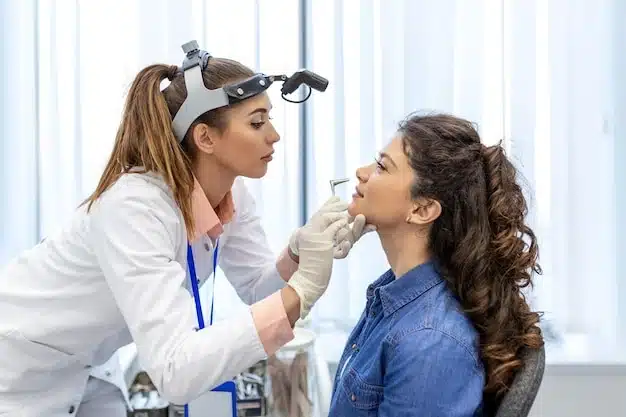
A crooked nose is caused by various factors affecting the structure of the nose, which includes the nasal bones, nasal bridge, and nasal cartilage. The nose’s anatomy is complex, comprising both bone and cartilage, which dictates our nasal appearance. Disturbances in this structure can lead to a crooked nose deformity.
The nasal septum, dividing the nasal cavity into two halves, is often the culprit behind alignment issues, arising congenitally or following an injury, resulting in a crooked or misaligned nose. Additionally, anomalies in the nasal bones or cartilages can lead to notable nasal asymmetry, not only altering the nose’s aesthetics but possibly its functionality as well.
Nasal asymmetry and deviations may affect the perceived masculinity or femininity of a face. Many individuals opt for rhinoplasty to correct a twisted nasal structure seen in crooked nasal deformity, with hopes of achieving a more feminine nasal profile or to enhance their appearance. Nevertheless, the objective transcends aesthetics; it encompasses improving functionality and ensuring the nose harmonizes with the rest of the facial anatomy.
Correct nasal asymmetry by realigning the nasal bones, remolding the nasal cartilages, and straightening the nasal septum.. The aim is to amend the appearance of a crooked nasal while remaining in sync with the facial anatomy. Achieving equilibrium and symmetry through surgery significantly enhances the nose’s function and look.
A thorough comprehension of the crooked nose anatomy—encompassing the nasal bones, nasal bridge, nasal cartilages, and the septum—is essential for effectively tackling and amending issues related to a crooked nose deformity.
Assessing Your Suitability for Rhinoplasty to Fix a Crooked Nose
When thinking about getting rhinoplasty to correct a crooked nose, it’s important to go through a careful evaluation to see if it’s the right decision for you. This starts with an initial consultation. At this stage, crooked nose patients will talk with a rhinoplasty specialist about both their cosmetic concern and functional concerns. Being open and honest about the changes you want is crucial.
A physical examination and medical history review follows. During this part, experienced surgeons assess your nose’s inside and outside structure and any effects your crooked nose may have on breathing. This helps the specialist gauge the complexity of your situation. Going over your medical history is also vital to ensure you’re fit for surgery, reducing any risks the procedure might carry.
Psychological considerations are equally essential. Rhinoplasty surgeons focus on patients having realistic expectations and a solid understanding of what the surgery can achieve. It’s important for the patient and surgeon to agree on the expected outcomes.
Finding the right surgeon has a big impact on your results. Seeking an experienced plastic surgeon means choosing someone with comprehensive training in facial procedures. Being double board-certified assures you’re in skilled hands, especially for the intricate task of correcting a crooked nose.
In essence, seeing if you’re suitable for rhinoplasty involves more than just physical readiness. It includes thinking about what you expect, your health, and the surgeon’s qualifications. Make sure your surgeon has significant experience, particularly a double-board-certified facial plastic surgeon who understands both the look and function issues associated with a crooked nose. This well-rounded approach aims for the best outcome for crooked nose patients.
Questions about your procedure?
Schedule a consultation with Dr. Andres Bustillo.
Rhinoplasty Techniques to Correct a Crooked Nose
When a patient looks into correcting a crooked nose, there are both surgical and non-surgical options available. Each method aims to achieve a more balanced look, and it’s vital for individuals to know about these techniques to make well-informed choices regarding their treatment.
Surgical Options for Straightening a Nose
Surgical techniques vary, each chosen based on what the patient needs. Crooked nose surgery usually involves modifying the nasal bones and cartilage. Sometimes, an advanced technique that involves breaking and then carefully resetting the nasal bones is used. This surgical procedure focuses on the nose’s underlying structure for lasting results. The execution of these techniques requires precision and a thorough knowledge of nasal anatomy.
Non-Surgical Alternatives
In contrast, non-surgical treatments like dermal fillers are minimally-invasive techniques. They work by filling in certain areas to mask small flaws, giving the appearance of a straighter nose. This option is easier on the patient with no recovery time, but unlike surgical procedures, the effects are not permanent and will need ongoing treatments to maintain.
Both surgical options for straightening a nose and non-surgical alternatives offer different advantages depending on what a patient is looking for. Whether it’s choosing a surgical procedure for a permanent fix or non-surgical treatments for less pronounced adjustments, there are now effective solutions available that cater to different needs and goals.
Preparing for Rhinoplasty Surgery to Fix a Crooked Nose
When thinking about fixing a crooked nose with rhinoplasty, good preparation is essential. Following preoperative guidelines can help make the surgery go smoothly and reduce Potential risks. It’s important to talk about possible Risks and Complications with your surgeon. Knowing these can help you have realistic expectations and make informed decisions.
Insurance is a big part of getting ready for surgery. Health insurance plans usually separate reconstructive surgery, which they often cover, from cosmetic nose enhancement, which is mostly not covered. Make sure to check your insurance plan to see if any part of your procedure could be considered medically necessary. For example, if a deviated septum is causing breathing problems, your surgery may get some coverage.
Before the surgery, there are several steps to take to lower risks and ensure a quicker recovery. It’s crucial to follow your surgeon’s advice, which may include:
- Changing your current medications.
- Avoiding supplements that could increase bleeding.
- Quitting smoking well before your surgery day.
Remember, every patient’s case and how insurance plans handle rhinoplasty can differ. If you’re looking into this surgery mainly for its cosmetic benefits, be prepared that you might have to pay the full cost. This underscores the value of a detailed preoperative consultation to discuss both your aesthetic aims and the financial side of things.
The Rhinoplasty Procedure to Fix a Crooked Nose Explained
Rhinoplasty, commonly known as nose job surgery, is sought after for correcting a crooked nose to improve both its function and looks. This cosmetic procedure is complex and requires a thorough knowledge of the nasal structure. This section explains the steps involved in the surgery, including Anesthesia and Incision Techniques, and what to expect during the postoperative recovery.
Anesthesia and Incision Techniques
The procedure starts with anesthesia to make sure the patient is comfortable and pain-free. The surgeon might use local anesthesia with sedation or general anesthesia, based on the specific needs of the case. This choice greatly affects the patient’s experience during and right after the surgery. Next, the surgeon decides on the incision technique. They might use a closed approach with incisions inside the nostrils, or an open approach that includes an incision across the columella, the thin strip of skin between the nostrils. This decision impacts the recovery time and the aesthetic outcome.
Steps of the Surgical Procedure
Once the anesthesia works, the surgeon makes incisions and begins correcting the shape of the nose. For a crooked nose, this usually means straightening the nasal septum through a process called septoplasty. Septoplasty is a precise task that requires adjusting the septum to improve both the look and function of the nose. Sometimes, correcting a crooked nose can also involve reshaping the surrounding tissue with aesthetic techniques for the best result.
Postoperative Recovery Process
Recovery from nose job surgery is an essential part. Swelling and bruising at the beginning are normal but will decrease over time. Following aftercare instructions carefully is important for healing. This includes keeping the head raised and avoiding heavy activities. A good recovery requires following these guidelines and going to follow-up appointments to ensure the nose heals well and the desired look is achieved.
In essence, fixing a crooked nose through rhinoplasty involves several detailed steps from choosing the right Anesthesia and Incision Techniques, to careful septoplasty, and attentive management of the recovery. Each of these stages plays a crucial role in realigning the nasal septal structure, thus improving both nasal function and aesthetic appeal.
Long-Term Results and Maintenance After Fixing a Crooked Nose
When fixing a crooked nose, it’s important to know the healing timeline and what to expect. Full recovery and achieving long-term correction involve several steps, eventually leading to an improvement of appearance and a boost in aesthetic confidence. In the beginning, swelling and changes right after surgery might hide the true results. But as you heal, the new look of your nose will start to show, usually settling within a year.
Maintaining the results of your rhinoplasty means following the care instructions from your surgeon. This includes staying away from activities that could harm the nose and going to all follow-up check-ups to see how it’s healing. For people who want to look better and also solve issues like trouble breathing, functional rhinoplasty is available. It fixes underlying problems and improves life quality.
Rhinoplasty procedures, whether for looks or function, aim for nostril symmetry and a balanced look. Sometimes, a revision rhinoplasty might be needed to adjust the look or fix small problems that appear after healing. This highlights the importance of choosing a skilled surgeon, as the success of getting the desired aesthetic confidence and functional benefits often depends on their expertise.
To keep your new nose shape, patience and strictly following aftercare are key to maintaining the integrity of the results.
It’s important to understand that achieving complete perfection might not be possible. Surgery can definitely bring significant improvements, but there are limits. That’s why clear communication between the surgeon and the Nose job patient is crucial. Discussing potential realistic outcomes openly, especially regarding any issues with confidence, ensures that the expectations align with what the surgery can genuinely offer.
If you want to fix a crooked nose and are thinking about rhinoplasty, it’s important to talk to an expert. Dr. Andres Bustillo has over 20 years of experience in facial surgery and is among the top in Miami. He focuses on giving you a natural look and makes sure you feel at ease during your visit.
To get advice tailored to your needs and learn more about how you can make the changes you want, schedule a consultation with Dr. Bustillo.
